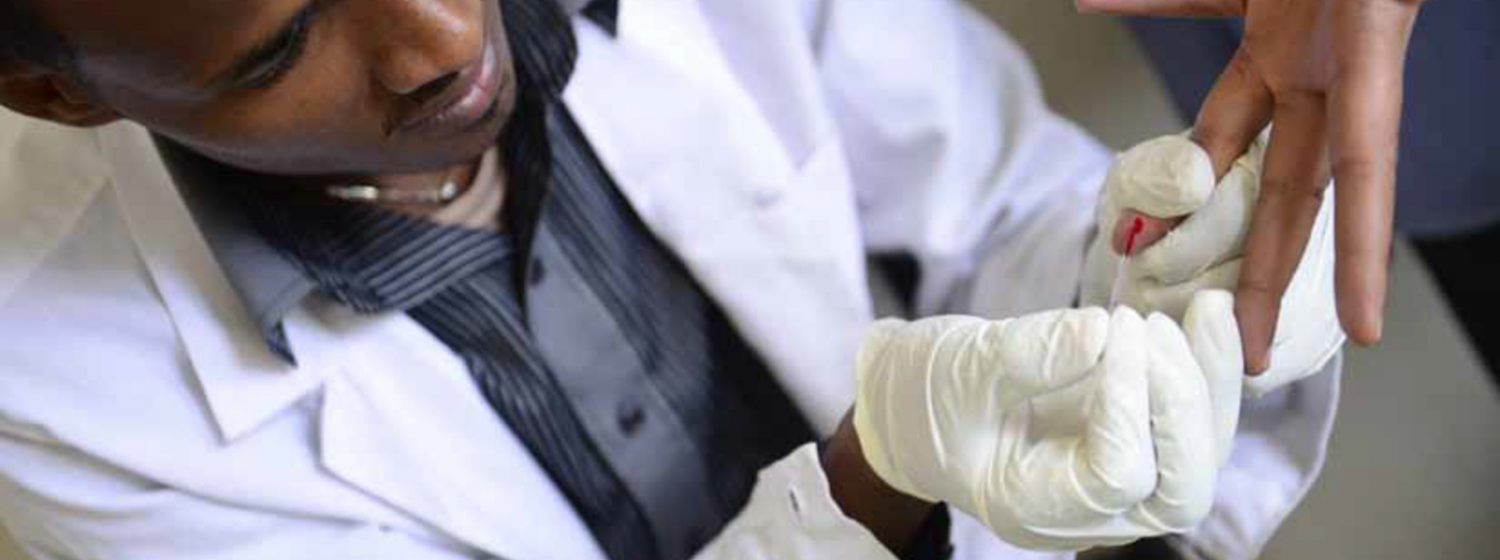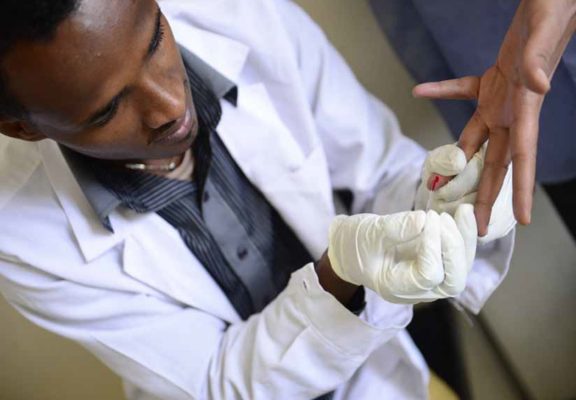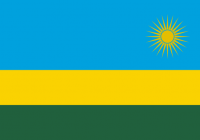


Rwanda
Rwanda is a landlocked East African country with a green, mountainous landscape. Its renowned Volcanoes National Park is home to mountain gorillas and golden monkeys. The park encompasses 4,507m-tall Mt. Karisimbi and 4 other forested volcanoes. In the southwest is Nyungwe National Park, with ancient montane rainforest that's a habitat for chimpanzees and other primates. Its population is 11.92 million (2016) and its GDP per capita is USD 738 (2016).
The quality of healthcare in Rwanda has historically been very low, both before and immediately after the 1994 genocide. In 1998, more than one in five children died before their fifth birthday, often from malaria.
In recent years Rwanda has seen improvement on a number of key health indicators:
- Between 2005 and 2013, life expectancy increased from 55.2 to 64.0,
- under-5 mortality decreased from 106.4 to 52.0 per 1,000 live births,
- incidence of tuberculosis has dropped from 101 to 69 per 100,000 people
Despite these improvements, however, the country’s health profile remains dominated by communicable diseases. Rwanda also has a shortage of medical professionals, with only 0.84 physicians, nurses, and midwives per 1,000 residents.
AHO PRIORITIES FOR HEALTH DELIVERY PLAN IN RWANDA
- Strengthening the capabilities of AHO in the delivery of health care services by upgrading the personnel skills in the areas of public health, HIV/AIDS, dental health, chronic disease management, health promotion, environmental health, pharmaceutical services, and quality assurance.
- Strengthening management and support services for enhanced delivery of health care services
- Development of health personnel.
- To improve the health and quality of life of the population.
- To provide technical cooperation that effectively and efficiently responds to national priorities.
- To promote health and human development to improve the health and quality of life of the population.
- To develop the public health system and services to improve the health and quality of life of the population.
- To develop health promotion and comprehensive care to improve the health and quality of life of the population.
PROGRAMMES & PROJECTS
1. HEALTH SYSTEMS AND SERVICES DEVELOPMENT
PURPOSE
To strengthen the capacity of health services to manage human, physical, and financial resources effectively and therefore encourage high standards in the delivery of health care .
EXPECTED RESULTS
- Skills of health workers improved in the area of epidemiology.
- Educational materials for healthy lifestyles developed.
- Standards improved in the areas of food safety, water quality, and pest control.
- Awareness enhanced regarding cancer and its relationship with environmental factors
- Health care delivery strengthened through technical cooperation visits.
- Community awareness created on immunization.
2. MANAGEMENT AND SUPPORT FOR THE NATIONAL DEVELOPMENT
PURPOSE
To make the technical cooperation provided to Venezuela, Aruba and the Netherlands Antilles respond effectively and efficiently to national priorities.
EXPECTED RESULTS
- Support for the development of public health strengthened.
- Management and coordination of the program strengthened.
3. HEALTH IN HUMAN DEVELOPMENT
PURPOSE
To consolidate the integration of health into social development through an equity, gender, ethnic, and life cycle approach, within the political and legal framework.
EXPECTED RESULTS
- Regulations and legal instruments formulated that permit the application and the policies, strategies, and plans that constitute the support required by AHO exercise its leadership of the Health System.
- Institutional, public, and private capacity strengthened for exercising the public health monitoring function as support for health management.
- Capacity of the AHO strengthened to incorporate the gender and equal opportunity approach into the policies, plans, programs, and strategies of AHO
4. DEVELOPMENT OF THE HEALTH SYSTEM AND SERVICES
PURPOSE
To consolidate the transformation of the sector, the steering role of AHO and the development of a Health System
EXPECTED RESULTS
- Technical capacity for implementing systems to promote programs and social networks integrated by territory strengthened
- State capacity strengthened at the national and state levels for the implementation of policies, exercise of the steering role in the development of human resources for health, and public health research
- Consolidation of a Pharmaceutical System capable of guaranteeing equitable access to high-quality, safe and effective drugs, which are administered according to basic criteria that ensure their more rational use.
- Consolidation of Communication to contribute to the improvement of access and the efficient use of scientific and technical information in the health sciences.
5. PROMOTION OF QUALITY OF LIFE AND OF HEALTH
PURPOSE
To develop and apply comprehensive care, encouraging health promotion and social development activities in priority groups, with a broad social participation.
EXPECTED RESULTS
- Capacity to develop integrated public policies and food and nutritional surveillance systems for the population strengthened, with an emphasis on priority groups.
- Capacity to formulate regulations, plans of action, and programs for adolescents and their sexual and reproductive health strengthened at the national level and in priority states to reduce maternal mortality and teenage pregnancies.
- Capacity to control and monitor the growth and development of children under 5 strengthened at the grassroots level through Community Health Facilities.
- Strengthened legal framework for executing national public policies for the prevention and control of smoking.
- Strengthened system for quality assurance and the surveillance of fluorine in food subject to compulsory fortification.
- Strengthened technical capacity of AHO at the national and state levels for carrying out activities related to mental health and human behaviour, within the framework of comprehensive care.
- Greater capacity to provide comprehensive care for older adults, the indigenous population, and people with disabilities, with emphases on health promotion and community participation.
- Greater technical capacity to develop campaign proposals for mass communication and inter-sectoral approaches and to create local social networks, seeking community organization and participation in health management and promotion.
6. DISEASE PREVENTION AND CONTROL
PURPOSE
To implement policies and strategies for comprehensive care with protection, promotion, prevention, control and rehabilitation activities for priority communicable and noncommunicable diseases, including zoonoses, FBDs, emerging and re-emerging diseases, and violence.
EXPECTED RESULTS
- Strategies developed for health promotion, the protection, prevention, and control of communicable diseases, and rehabilitation.
- Surveillance systems strengthened, with a special focus on laboratory diagnoses and services for emerging and re-emerging diseases, as well as prevention.
- Human and animal health services infrastructure strengthened.
- Capacity strengthened for the design and execution of operations research for communicable and noncommunicable diseases.
7. ENVIRONMENTAL PROTECTION AND DEVELOPMENT
PURPOSE
To develop the technical capacity of the health and environmental sector to evaluate and monitor environmental determinants, and to develop campaigns for environmental protection, risk prevention, and response to emergencies and disasters.
EXPECTED RESULTS
- Proposals formulated for policies/laws/regulations/standards in the field of environmental health and protection and emergencies and disasters.
- Institutions in the field of environmental health, emergencies, and disasters strengthened.
8. IMPLEMENTATION OF COOPERATION IN HEALTH AND SOCIAL DEVELOPMENT
PURPOSE
To strengthen the institutional capacity of AHO for the coordination, mediation, and effective and systematic utilization of technical and financial cooperation that the country receives and offers, nationally and internationally
EXPECTED RESULTS
- Greater capacity for coordinating technical cooperation in public health and social development with other national and international actors.
- Greater capacity for mediation and monitoring of the various technical cooperation activities carried out
- Capacity for the preparation and implementation of projects for technical cooperation among countries strengthened.
RESOURCES (USD)
AHO RWANDA 2020 (USD million)* based on 2017 pop 12.21 million World Bank
| SO | BUDGET ITEM | AMOUNT* |
| 1 | Combating communicable diseases |
203 |
| 2 | Tackling non communicable diseases |
210 |
| 3 | Addressing determinants of health & risk factors |
205 |
| 4 | Modernising health system and health service |
204 |
| 5 | Improving preparedness, surveillance and response |
200 |
| 6 | Developing good governance & corporate services |
199 |
| Total |
1,221 |
AHO estimates that it needs to spend at least USD100 per capita on health to meet the basic health needs of the people in Africa. This is too far below developed countries e.g. in England it is US$1,300 per capita (2017)

